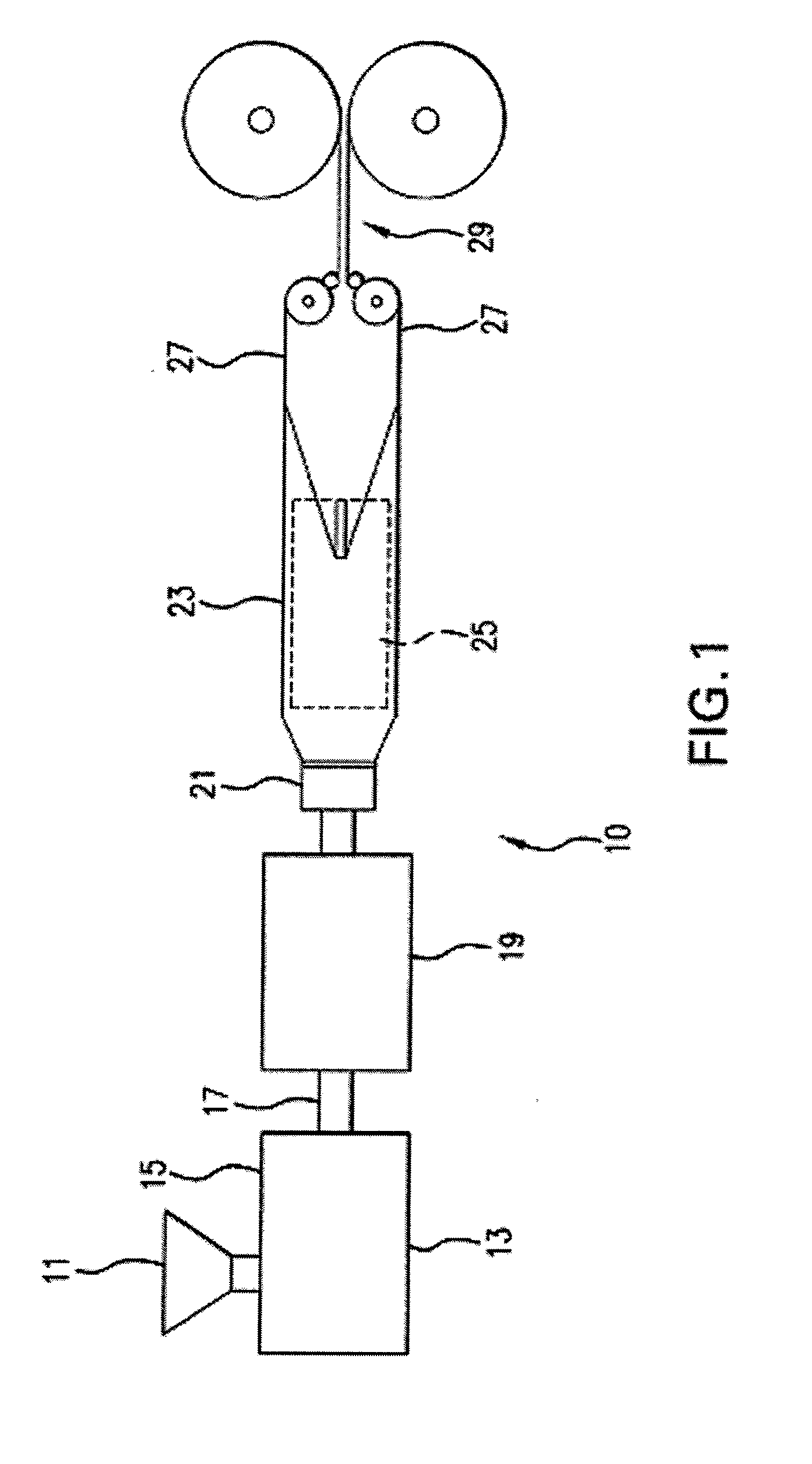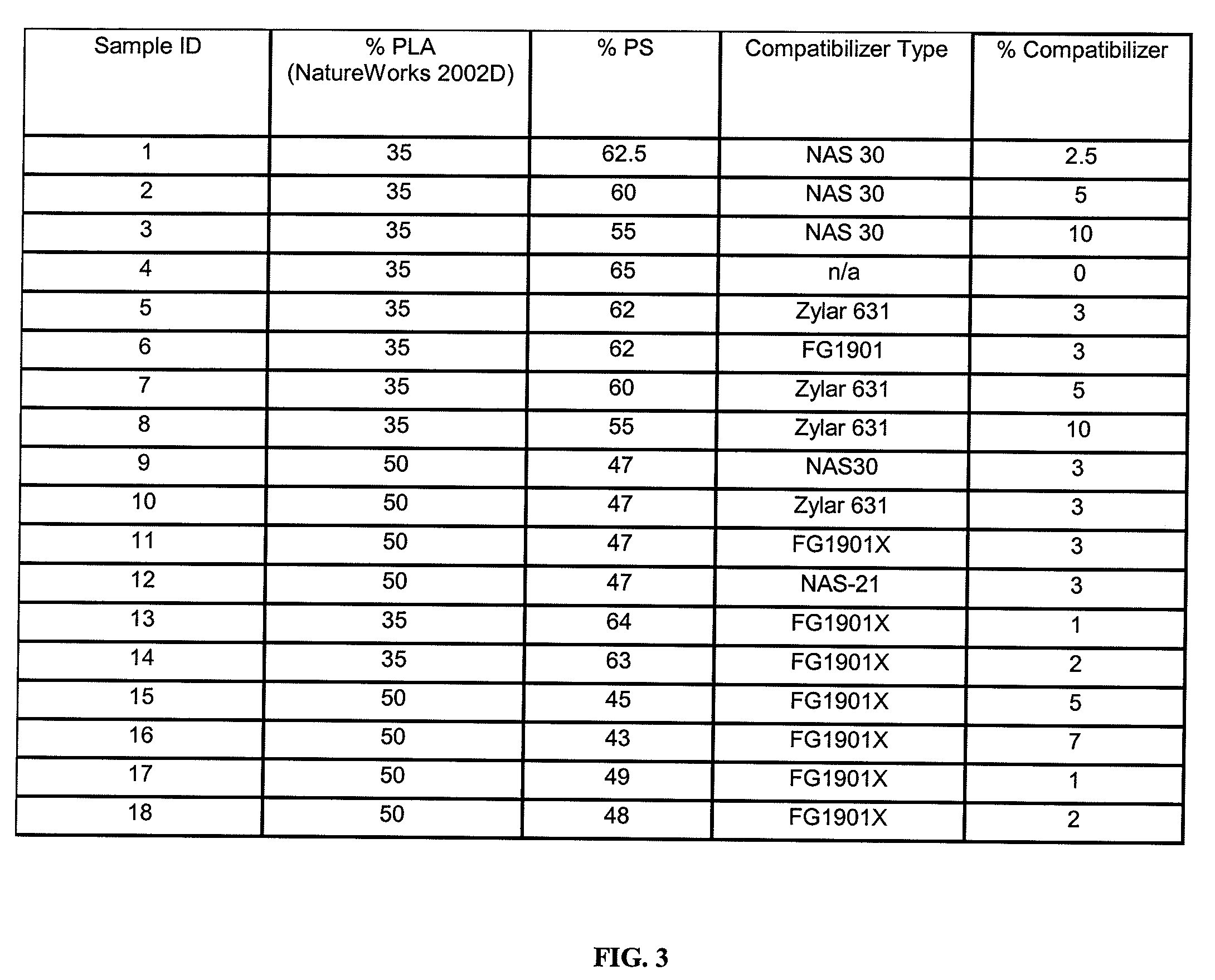Polymer Blends Of Biodegradable Or Bio-Based And Synthetic Polymers And Foams Thereof
a technology of biodegradable or bio-based polymers and synthetic polymers, which is applied in the field of polymer blend compositions, can solve the problems of requiring a tremendous amount of energy, affecting the development of environmentally friendly materials, and many of these materials have little, if any, functional degradability
- Summary
- Abstract
- Description
- Claims
- Application Information
AI Technical Summary
Benefits of technology
Problems solved by technology
Method used
Image
Examples
examples
[0054]Various blend compositions were prepared and tested with the compositions prepared and results of the testing set forth in FIGS. 3-7. For the purpose of comparison, a polystyrene control sample was prepared from a commercially available crystal polystyrene resin with a MI of about 1.5 g / 10 min (200° C. / 5 kg). The blend samples were prepared from the commercially available polystyrene resin blended with a PLA that is NatureWorks 2002D resin with a MI of 5-7 g / 10 min (210° C. / 2.16 kg).
[0055]The testing blend compositions included polystyrene (PS) as the alkenyl aromatic polymer component, and polylactic acid (PLA) as the biodegradable or bio-based polymer component.
[0056]The bio-based or biodegradable polymers used in the blend composition can be any suitable bio-based or biodegradable polymers. One exemplary type of polymers are bio-based or biodegradable polymers with narrow molecular weight distributions, having linear structure and a melt index of from about 0.1 to about 20 ...
example a
[0058]Eighteen blends were prepared according to the formulations illustrated in FIG. 3. The blends were compounded on a 34 mm Leistritz twin screw extruder. The PLA was dried in a Maguire Vacuum drier at 120° F. for 20 minutes. After drying, the PLA was dry blended with the PS and blend compatibilizer or compatibilizers in a batch mixer and then introduced to the line. The temperature profile on the extruder ranged from 360° F. to 375° F. The extruder was set to operate at screw speed of 8 rpm and at a throughput of 40 lb / hr.
[0059]The PS-PLA compounded blends were foamed on a lab scale Gloenco tandem-extruder. The compounded samples were typically dried in a Maguire low pressure dryer for 20 min at 120° F. before starting the runs. About 1% talc nucleating agent in a PS masterbatch (50% talc and 50% PS) was mixed with the sample prior to feeding to the extruder. The melt temperature was set at 145° C. and then adjusted accordingly to yield the best foaming for a given sample. The a...
example b
[0064]A pilot scale tandem extrusion system was used to foam the formulations detailed in FIG. 5. These samples were prepared having 40%-44% polystyrene, 51%-55% polylactic acid, and 5% blend compatibilizer. Kraton FG1901X was used as the blend compatibilizer for all of these samples. A mixture of iso-pentane and CO2 was used in the foam trials. The blowing agent levels of about 3% to about 4% by weight, secondary extruder RPM of about 14 to about 19, melt temperature of about 286° F. to about 291° F. and output of about 138 to about 160 lb / hr are summarized in FIG. 6.
[0065]As summarized in FIG. 5 the testing results for the three samples prepared indicated densities of approximately 0.10-0.11 g / cm3 for the three samples. Sample 21 had 20.1% open cell content, a basis weight of 7.0 g / 100 in2, and a gauge of 0.039 inches. Sample 22 had 51.2% open cell content, a basis weight of 7.8 g / 100 in2 and a gauge of 0.045 inches. Sample 23 had 66.0% open cell content, a basis weight of 8.0 g / 1...
PUM
| Property | Measurement | Unit |
|---|---|---|
| Fraction | aaaaa | aaaaa |
| Fraction | aaaaa | aaaaa |
| Fraction | aaaaa | aaaaa |
Abstract
Description
Claims
Application Information
 Login to View More
Login to View More - R&D
- Intellectual Property
- Life Sciences
- Materials
- Tech Scout
- Unparalleled Data Quality
- Higher Quality Content
- 60% Fewer Hallucinations
Browse by: Latest US Patents, China's latest patents, Technical Efficacy Thesaurus, Application Domain, Technology Topic, Popular Technical Reports.
© 2025 PatSnap. All rights reserved.Legal|Privacy policy|Modern Slavery Act Transparency Statement|Sitemap|About US| Contact US: help@patsnap.com



